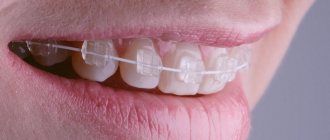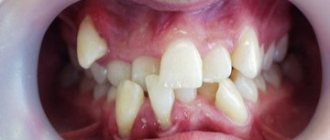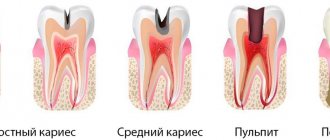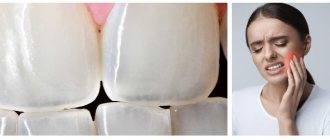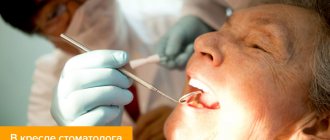Each tooth in a row has its own unique shape; it is standard for every person. Of course, this does not mean that all people on the planet have the same teeth. On the contrary, dental impressions, like fingerprints, are unique in their anatomical features.
The presence of deviations in the formation of dental crowns from the standard, physiological form is called an anomaly in the development of tooth shape. As a rule, abnormal tooth shapes are combined with changes in the size of the dental units.
Reasons contributing to the development of abnormal tooth shapes
Based on numerous studies, scientists have come to the conclusion that the formation of dental anomalies occurs during pregnancy.
There are two main reasons that contribute to the abnormal development of tooth shape:
- Endogenous (independent of external factors, inherent within the body) - Down syndrome, Shershevsky-Turner syndrome, Waardenburg syndrome, Seckel syndrome, Lobstein-Vrolik disease (osteogenesis imperfecta), endocrine disorders.
- Exogenous (the result of external influences) - fetal hypoxia, deep toxicosis, infectious diseases of the mother, use of drugs, alcohol, narcotics during pregnancy, complicated childbirth.
Due to the above reasons, hypoplasia (underdevelopment) of tooth enamel may develop, which also leads to deformation of dental units.
Possible consequences
Improper development of teeth and abnormal bite cause uneven distribution of chewing load. This leads to the development of various complications:
- rapid abrasion of closing teeth;
- caries, pulpitis;
- gingivitis, periodontitis;
- bleeding of the mucous membrane;
- displacement of the articular head of the temporomandibular joint.
When bite deviations occur, problems arise with oral hygiene and microcirculation in the periodontal tissues is disrupted. Ultimately, cellular nutrition, gas exchange, and metabolism are disrupted. A complex of pathological processes leads to early destruction of dentin, periodontal ligaments and tooth loss. Timely consultation with a doctor will help prevent adverse consequences. In Moscow, jaw bite correction is carried out by the Center for Aesthetic Dentistry near the Otradnoye metro station.
Types of tooth shape anomalies
The abnormal shape of the dental crown is mainly distinguished by the front, lateral incisors, both upper and lower, supernumerary teeth, and less commonly, molars.
Depending on the appearance of the manifestation of the pathology, anomalies in the shape of the teeth have the following varieties:
- Giant teeth - an increase in the central incisors by one and a half times. The result is a violation of physiological occlusion.
- Spike-shaped teeth - the central and lateral incisors of the upper jaw and the lateral incisors of the lower jaw acquire this shape.
- Ugly teeth - come in many forms; the crowns of the anterior teeth are affected.
- Fournier's teeth - the incisors of the central part of the upper jaw have a barrel-shaped, screwdriver-shaped appearance. The cutting edge of the dental crown is smaller than its neck.
- Hutchinson's teeth differ from Fournier's teeth by the presence of a semicircular hole on the cutting surface of the tooth. The enamel in this place is thinned, or even completely absent.
- Pflueger's teeth - the first molars are modified. They differ in the smaller size of the chewing surface from their coronal part.
Microdentia of permanent teeth is not a death sentence!
July 17, 2018
What is microdentia? This is a pathology of the development of the dental system, which is characterized by a reduced size of one or more teeth. One type of microdentia is spiky teeth.
As a rule, this pathology is combined with obvious orthodontic disorders, but it is also possible without orthodontic pathology. In this article I would like to present to your attention just such a clinical case, which at first glance seemed to me not so difficult, which I later disabused myself of. So…
| NIKITA GOLOVIN doctor - orthopedic dentist, graduate student of the Department of Orthopedic Dentistry and Orthodontics of the Federal State Budgetary Educational Institution of Higher Education "Southern State Medical University" of the Ministry of Health of the Russian Federation Nikita Golovin is the head of the media center of the International Dental Association (IDA) and coordinator of IDA projects in the Chelyabinsk region. His area of responsibility includes regular educational lectures and exclusive lessons for dentists of all specialties, volunteer projects, and support for the donor movement in the region. |
Patient N., 32 years old, came to us to improve the aesthetic aspect of her smile. According to the patient, from the moment the lateral incisors on the upper jaw erupted, they had an irregular, ugly shape. During the initial examination, it was revealed that the teeth erupted on time, but had the shape of a pointed cone and were smaller than the required size.
Teeth 1.2 and 2.2 are intact. A targeted radiography of teeth 1.2 and 2.2, as well as orthopantomography, was performed. There were no visible pathological changes in the pulp and periodontium on radiographs. Interdental contacts with adjacent teeth were tight.
As a result, the patient was diagnosed with “K00.2 Anomalies in the shape and size of teeth. Microdentia" and a decision was made to restore this aesthetic defect.
Since, in addition to satisfying the aesthetic desires of the patient, we needed to take into account the functionality of the future restoration, as well as the lack of need and desire of the patient himself to change the shade of the teeth, we jointly decided to restore the shape and size of only these teeth (1.2 and 2.2) with indirect adhesive ceramic restorations based on lithium disilicate (IPS E-max® Press) followed by ceramic lining.
Since there are no indications for depulping these teeth when choosing this design, the preparation was as gentle as possible, but nevertheless necessary. Since contact points with neighboring teeth existed, but had an incorrect configuration, during preparation they were opened and the boundaries of the restoration on the mesial and distal surfaces were located more palatally. Actually, this is where the dissection ended, since there was no need for more.
Next, a one-stage, two-phase impression was taken using an A-silicone impression compound with the rigidity of the Heavy base mass and the corrective one, Super Light Body, which ensured high-quality penetration of the gingival sulcus without excessive pressure from the base impression mass. The color of the future restoration was determined - LT A2.
Without going into technical issues, since this is a topic for a separate article, indirect restorations were manufactured that had a half-crown format. Fixation with adhesive light-curing cement according to the adhesive protocol.
In this case, it was possible to fully satisfy the patient’s aesthetic requirements and ensure the functionality of the restoration. The shape of the teeth was restored, and the correct contact points with neighboring teeth were created.
At a follow-up examination 6 months after fixation, the fit of the restorations to the TTZ was not broken, there were no chips or cracks, and the color stability of the restorations was at the same level. Thus, the end result was a complete restoration of aesthetics and function.
Condition before restoration |
| Condition after restoration |
6 months after restoration
see also
July 18, 2018
How we make lasers
The path to establishing the Biolase brand is not easy. Here, for more than twenty years, technologies have been created and developed - perhaps the most complex in the field of laser medicine. Dmitry Butusov, chief engineer and vice president of Biolase, tells his professional story, which is directly related to the history of the company for 18 years.
July 9, 2018
Connected by one goal
International Dentistry Association - International Dental Association, an association of young dentists and students, which has existed for the sixth year. Today IDA is represented in 16 cities of Russia and 3 countries of the world (except Russia, these are Armenia and Jordan). The association involves over 5,500 people, including its members, volunteers and activists who implement various projects of the youth organization throughout the country.
June 27, 2018
Toothworm and ancestral spirits: The most amazing myths about teeth
Neanderthals also suffered from toothache. They were most likely the first to try to explain where teeth come from and who gnaws holes in them. By the time the first civilizations emerged, different peoples already had hundreds of myths about teeth. Many of them turned out to be surprisingly tenacious.
June 19, 2018
Protective mechanism: Rapid tests for hepatitis C and HIV
The HIV and viral hepatitis pandemic is one of the most difficult problems facing humanity today. In Russia, many experts have long called the situation with these diseases catastrophic. For dentists, who are the most frequently visited doctors, this problem is very acute.
June 15, 2018
The golden mean of implantology
The science of dental implantology has been developing for more than forty years. Thanks to the continuous study of implants, their surface and design features, “gold standards” in this direction are gradually emerging. Time-tested standards combined with high technology serve modern medicine. Return to section
Diagnosis of tooth shape abnormalities
Consultation with an endocrinologist and geneticist will help determine the cause of this pathology. Choosing the right method for eliminating pathology is the job of a dentist, orthodontist, or surgeon.
For diagnosis, it is necessary to undergo a series of studies, which include:
- careful collection of anamnesis;
- studying diagnostic casts of the patient’s dentition;
- cone tomography;
- various types of radiographic examinations;
- electromyography (study of the functionality of facial muscles).
Peculiarities
Dental crowding is a pathology characterized by:
- incorrect angle of rotation of some teeth relative to the rest (tortoanomaly),
- vestibular (outward) or palatal (inward) inclination of the teeth,
- “pile up” of teeth, their position is too close,
- eruption of teeth outside the dental arch due to lack of space in the dentition.
Depending on the severity, crowding of teeth can be:
- mild - crowding on one jaw is about 2-3 mm, no more than 2-3 teeth are crooked;
- medium - the displacement reaches 4-65mm;
- severe - more than 6 mm, many teeth are displaced, which is clearly visible to others;
- very severe - the lack of space in the dental arch reaches 7-8 mm, the position of all or almost all teeth is disturbed.
Methods for treating abnormal tooth shapes
It is important to remember that treatment of any pathology associated with correcting the shape of dental crowns begins after the formation of a permanent bite. Anomalies in the shape of teeth are primarily a big aesthetic problem.
Methods of modern prosthetics make it possible to correct almost the most complex cases of dental anomalies:
- Restoration using ceramic veneers - such microprosthetics are performed by attaching a thin ceramic plate to the previously prepared front surface of the tooth. This procedure allows you to cope with the rather complex task of smile aesthetics in a short period of time.
- Prosthetics with crowns is considered appropriate when additional strengthening of the tooth is required. The material for making crowns can be different: a metal alloy of medical or noble metals, metal-ceramics, metal-plastic, ceramics. The choice depends on the aesthetic preferences and financial capabilities of the patient.
- Restoration with composite materials is possible for minor dental anomalies. It is one of the most affordable and fastest methods of dental crown reconstruction.
- Tooth resection - supernumerary and giant dental units are removed. This is followed by bridge prosthetics or installation of dental implants.
Treatment
Treatment of abnormalities in the position, size and shape of teeth is carried out mainly surgically. When reducing the size of a tooth, prosthetics, implantation or restoration are used.
You can change the shape of a tooth using veneers and laminates made from composite filling materials or ceramics. If the teeth are in an abnormal position, they are moved or removed and then replaced with a prosthesis. The first is implemented using special devices or plates that cause compression of the teeth and their displacement. For this purpose, removable and non-removable orthodontic devices, braces, and a face bow are used.
Complex dental anomalies require an integrated approach to treatment, which will correct the bite and completely eliminate the defect. During a consultation at the Mositalmed clinic network, the dentist will select the necessary treatment regimen, taking into account the individual characteristics of the patient and the clinical picture. The production of implants in our clinic is carried out using reliable technology and high-strength materials.
Prevention of dental abnormalities
The only method of preventing this disease is to provide the expectant mother with appropriate conditions:
- nutritious, varied nutrition;
- regular, high-quality medical care;
- protection from stressful situations.
It is necessary to forget about existing bad habits during pregnancy and breastfeeding. Particular attention should be paid to the development of the child in the first year of life. Natural feeding and prevention of rickets are a solid foundation for the excellent health of the baby.


